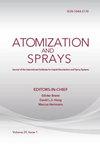Experimental study on the spray pattern and the merging process of dual-layer rotating conical liquid sheets
IF 0.9
4区 工程技术
Q4 ENGINEERING, CHEMICAL
引用次数: 0
Abstract
To comprehensively deepen the understanding of the primary breakup mechanism of dual-layer rotating conical liquid sheets, the spray field of a dual-orifice pressure-swirl atomizer was photographed using a high-speed shadowing method. The relationship and mechanism of the influence of the pressure-drop change of primary and pilot flow channels, and dual-layer liquid sheets merging on spray morphology, spray cone angle, and liquid sheet surface fluctuations were investigated in detail based on the analysis of spray field pictures. Attention was focused on the disturbance wave-change mechanism of the dual-layer liquid sheet merging process. The study shows that changing the pressure drop in the primary and pilot flow channels lead to changes in spray pattern, spray cone angle, and liquid sheet surface fluctuations. Furthermore, the influence of pressure drop in the primary flow channel is dominant, and the change in liquid sheet surface fluctuations is related to the spray pattern. In the process of liquid sheet merging (after the inner liquid sheet reaches the expected spray cone angle) the spray cone angle of the outer liquid sheet reduces in size, and only after the dual-layer liquid sheets are in contact with each other do the amplitude of the surface fluctuations of the liquid sheet become significantly larger and generate more medium- and high-frequency scatter.双层旋转锥形液片的喷射模式和合并过程的实验研究
为全面深化对双层旋转锥形液片一次破裂机理的认识,采用高速阴影法拍摄了双孔压力漩涡雾化器的喷雾场。在分析喷雾场图片的基础上,详细研究了主、先导流道压降变化和双层液片合并对喷雾形态、喷雾锥角和液片表面波动的影响关系和机理。重点研究了双层液片合并过程的扰动波变化机理。研究表明,改变主流道和先导流道中的压力降会导致喷雾模式、喷雾锥角和液面波动的变化。此外,主流道压降的影响占主导地位,液面波动的变化与喷型有关。在液片合并过程中(内层液片达到预期的喷雾锥角后),外层液片的喷雾锥角减小,只有在双层液片相互接触后,液片表面波动的振幅才会明显变大,并产生更多的中频和高频散射。
本文章由计算机程序翻译,如有差异,请以英文原文为准。
求助全文
约1分钟内获得全文
求助全文
来源期刊

Atomization and Sprays
工程技术-材料科学:综合
CiteScore
2.10
自引率
16.70%
发文量
54
审稿时长
1.7 months
期刊介绍:
The application and utilization of sprays is not new, and in modern society, it is extensive enough that almost every industry and household uses some form of sprays. What is new is an increasing scientific interest in atomization - the need to understand the physical structure of liquids under conditions of higher shear rates and interaction with gaseous flow. This need is being met with the publication of Atomization and Sprays, an authoritative, international journal presenting high quality research, applications, and review papers.
 求助内容:
求助内容: 应助结果提醒方式:
应助结果提醒方式:


